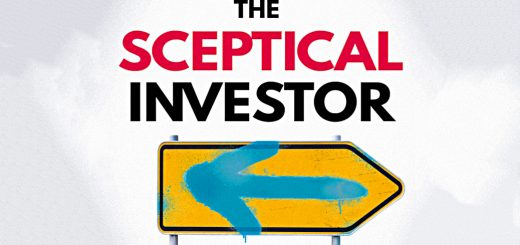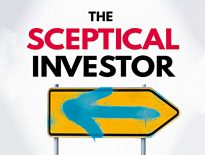The Sceptical Investor 5 – Value, Turnarounds and Funds

Today’s post is our fifth visit to a popular UK investing book from last year – The Sceptical Investor by John Stepek.
Value
Chapter 13 switches the focus from markets to companies, and looks at value investing.
We should all be familiar with this approach to investing.
- It is one of the most famous of all techniques, and was popularised by Ben Graham and Warren Buffett.
I won’t go into too much detail on the basic concepts, which include:
- The intrinsic value of a stock
- This is usually derived from future cash flows, but will be different for each investor (ie. is subjective)
- Mr Market
- A manic depressive character who offers you a price each day which could be lower or higher than the intrinsic value
- The margin of safety
- The degree to which the current market value is lower than the intrinsic value.
- Note that limits downside as well as providing upside.
- Cigar butts
- Burnt out stocks with just a few puffs of value left within them.
- These were popular in the early days of value investing, but actually quite a high risk approach.
- QARP / GARP (Quality / Growth at a Reasonable Price)
- The most prevalent forms of value investing these days.
- These companies should compound returns and can be held for the long term.
The basic strategy within value investing is buying firms when the market price is too low, and selling them when the market price is too high.
- A stock need not be cheap relative to the market to be a buy.
- And a cheap stock may not be a bargain (it could be a “value trap” instead).
John highlights a few principles for value investors:
- Think like an owner, not a trader.
- Risk is about losing money, not price volatility.
- Understand how the business makes money.
- How good is it? (eg. look at ROCE)
- Can it keep the good performance going?
- Does the management have integrity?
- Patience is a weapon (use a watchlist).
- Be wary of leverage and debt.
- Don’t be afraid to focus (have a concentrated portfolio).
It’s not a bad set of rules, though I would caution that a concentrated portfolio is for experts only.
Turnarounds
Chapter 14 is about turnaround situations, “falling knives” (stocks that have recently dropped in price) and profit warnings.
We not fans of catching falling knives – see here for more detail.
- And we thing you should sell on a profit warning.
John doesn’t disagree in general, so once again we don’t need to dig into the details too much.
Falling knives are attractive because of anchoring – we still believe the stock is worth the old, higher price.
- But in fact, markets initially under-react to profit warnings (the endowment effect and confirmation bias stops owners from selling).
The price is likely to fall further, for around a year.
- And the first profit warning is usually followed by more bad news.
John recommends that you ignore falling stocks that weren’t already on your watchlist.
He has couple of pointers for weeding out the dead firms from the recovery plays:
- Look for one-off incidents and put together the worst-case scenario.
- This would have helped with the recent BP and Volkswagen scandals.
- Does the market really hate this stock yet?
And he has a short list of red flags:
- Avoid heavily shorted stocks.
- Beware complicated changes to accounting rules.
- Beware of high levels of debt.
Contrarian fund managers
Chapter 15 is about finding a contrarian fund manager.
Once again, John has a checklist of what to look for:
- A defined, transparent strategy and a process that they can explain to you.
- A high conviction, low turnover, portfolios with no sign of closet indexing (high active share).
- A small, boutique fund from an independent thinker.
- Skin in the game (manager holdings in the fund).
- Low costs and fair fee structures
He also recommends that you are patient in building a portfolio of contrarian fund managers.
- You should diversify across them,
- And you should not chase recent outperformance.
He also recommends investment trusts (as do we – see our list here).
Rebalancing
We’ve written a couple of times about rebalancing already – here and here.
There are three basic rules:
- Use cash flows (in or out of the portfolio) if you can
- Don’t rebalance too often (or you’ll miss out on momentum)
- Don’t buy into things that are going down (momentum again)
John’s take is simpler – he just wants to see regular rebalancing.
- He prefers that it should be no more frequent than annually – which is fine but not optimal.
- And he recommends threshold rebalancing (where you only sell when the overweight hits a certain size) – which is also fine.
Conclusion
That’s it – we’ve reached the end of the book.
Let’s start with John’s key takeaways:
- Nothing lasts forever
- People think in straight lines, but life moves in cycles.
- Slow down
- Deploy your brain, rather than trusting your gut.
- Look for the incentives
- An individual will take the path of least resistance.
Not a bad set of principles.
I must confess that the book has been somewhat disappointing for me, largely because of the lack of actionable strategies.
- My only takeaway is the Meb Faber CAPE rotation, and that’s a reminder rather than new information.
Overall, the book reads like a potted history of investing, put together by a journalist rather than someone actively managing their own sizeable portfolio.
That said, I think it would be very useful to a novice investor, as one of the first five or ten investment books that they read.
- And it’s well written and a fun and easy read.
So on that limited basis I would recommend it.
I’ll be back in a few weeks with an article summarising the lessons from the whole of the book.
- Until next time.














